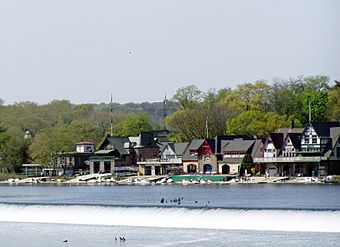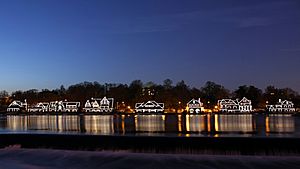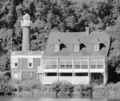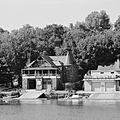Boathouse Row facts for kids
|
Boathouse Row
|
|

Boathouse Row
|
|
| Lua error in Module:Location_map at line 420: attempt to index field 'wikibase' (a nil value). | |
| Location | Philadelphia, Pennsylvania |
|---|---|
| Area | 12 acres (4.9 ha) |
| Built | 1860 |
| Architect | Furness & Evans, et al. |
| Architectural style | Late 19th- and 20th-century Revivals; Late Victorian; Gothic |
| NRHP reference No. | 87000821 |
Quick facts for kids Significant dates |
|
| Added to NRHP | February 27, 1987 |
| Designated NHL | February 27, 1987 |
Boathouse Row is a famous place in Philadelphia, Pennsylvania. It sits on the east side of the Schuylkill River. You can find it just north of the Fairmount Water Works and the Philadelphia Museum of Art.
Boathouse Row is a line of 15 unique buildings called boathouses. These buildings are home to different clubs for rowing and social activities. They also store the special boats, called racing shells, that rowers use. Each boathouse has its own story. All of them have addresses on both Boathouse Row and Kelly Drive. Kelly Drive is named after a famous Philadelphia rower, John B. Kelly Jr..
Most of the boathouses (numbers 2 through 14) are part of a group called the Schuylkill Navy. This group includes other boathouses along the river too. Boathouse #1 is called Lloyd Hall. It is the only boathouse on the Row that is open to the public. Boathouse #15 is home to the Sedgeley Club. This club also takes care of the nearby Turtle Rock Lighthouse. All the boathouses are very old, some are even more than 150 years old!
Contents
Why Boathouse Row is Special
Boathouse Row is a very important place for the sport of rowing. Many big rowing races, called regattas, happen here. Some of these famous races include the Aberdeen Dad Vail Regatta, the Stotesbury Cup Regatta, and the Head of the Schuylkill.
Rowers from these boathouses compete at all levels. This includes local clubs, high schools, colleges, and even international competitions. It's a central spot for the rowing community across the United States.
In 1979, special lights were added to outline each boathouse. An architect named Ray Grenald designed these lights. He wanted to make the old buildings more noticeable and appreciated. At night, the lights make the boathouses look like glowing gingerbread houses, and their reflection shines in the Schuylkill River. In 2005, the lights were updated with modern LEDs. These new lights can change colors for different events or seasons.
Boathouse Row is so important that it was named a National Historic Landmark in 1987. This means it's a place recognized for its special history in the United States.
Many local universities use the boathouses for their rowing teams. These include Drexel University, University of Pennsylvania, and La Salle University. Other universities like Temple and Saint Joseph's also row on the Schuylkill River, but from different boathouses nearby.
A Look Back at History
The story of Boathouse Row began with the building of the Fairmount Dam in 1821. This dam helped keep salty ocean water out of the city's drinking water supply. The dam also changed the Schuylkill River. It turned a fast-moving, tidal river into a calm, long freshwater lake. This calm water was perfect for activities like ice skating in winter and rowing in summer.
The first rowing race here happened in 1835. It was between two clubs called the Blue Devils and the Imps Barge clubs. This race made people excited about rowing, and soon many new rowing clubs started.
As the river became calmer, wealthy people moved away from their riverside homes because of mosquitoes. The city of Philadelphia bought these empty estates. In 1844, the city bought the Lemon Hill Estate. The people renting Lemon Hill allowed rowing clubs to build simple wooden boathouses on the property.
In 1855, the city created Fairmount Park from the Lemon Hill Estate. At the same time, some rowing clubs wanted to make rowing a fair sport. So, in 1858, they formed the Schuylkill Navy. This group helped turn rowing into an amateur sport, meaning people competed for fun, not money. In 1859, the city decided to remove the old wooden boathouses.
Building the Boathouses We See Today
Even though the city removed the old boathouses, they allowed new ones to be built in 1860. These new buildings were stronger, made of brick and stone. Over the years, more boathouses were added or rebuilt.
For example, between 1869 and 1871, the Pennsylvania Barge Club and Crescent Boat Club built a shared boathouse. Later, in 1871, the University Barge Club and the Philadelphia Barge Club built another shared boathouse. Many other clubs, like Malta Boat Club, Vesper Boat Club, and College Boat Club, built their own boathouses in the 1870s.
Some of the original 1860 boathouses were replaced over time with newer, stronger structures. For instance, Bachelors Barge Club rebuilt its boathouse in 1894. The Sedgeley Club built Boathouse #15 in 1902. Today, only a few boathouses from 1860 remain, like #3 and #14. This shows how the Boathouse Row has grown and changed over many years!
Images for kids
-
Sedgeley Club,
#15 Kelly Drive (1902) -
Philadelphia Girls' Club,
#14 Kelly Drive (1860) -
Undine Barge Club,
#13 Kelly Drive (1883) -
Vesper Boat Club,
#10 Kelly Drive (1873) -
Malta Boat Club,
#9 Kelly Drive (1873) -
Crescent Boat Club,
#5 Kelly Drive (1871) -
Pennsylvania Barge Club,
#4 Kelly Drive (1892) -
The Row with Lemon Hill in the background (around 1860-71)
-
Boathouse Row from the Water Works (around 1873-74)
-
Boathouse Row from Lemon Hill (around 1873-74)
























